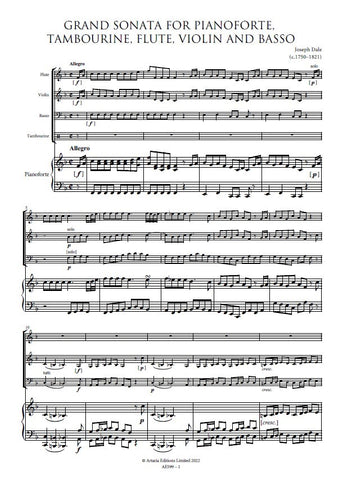Description |
Pleyel, Ignaz (1757-1831)
|
||||||||||||||||||||
Details |
The Piano Trio in B (Benton 433) is the third of a group of six sonatas composed by Pleyel around 1788. Many of the early editions carry a dedication to the Queen of England; those issued by English publishers state clearly that the works have been dedicated by permission to Her Majesty the Queen which may or may not point to Pleyel having influential admirers in England as early as 1788. In keeping with the flexibility common to this type of music, the works were advertised as being suitable for either violin or flute. Some editions assign the first three sonatas to the violin and the second three to the flute; others do not differentiate between the two. The works were hugely popular and numerous editions appeared from 1788 until well into the 19th Century. This edition is based on a print issued in 1787 by the London publishers Longman and Broderip. The title page of the print reads: SIX SONATAS / FOR THE / Piano Forte or Harpsichord / With an Accompaniment for a / FLUTE or VIOLIN and VIOLONCELLO / Composed and Dedicated (by Permission) to / HER MAJESTY / The Queen of Great Britain / by Ignace Pleyel / London The keyboard part in this source is labelled cembalo but there is no doubt whatsoever that the music was conceived for fortepiano. This is evident not only from the proliferation of dynamic indications in the score but also from Pleyels careful inclusion of slurs and phrase markings. In the absence of an authoritative source, the present edition seeks to transmit as unambiguously as possible the composers intentions as transmitted in the Longman and Broderip print. The notation of articulation and dynamic markings has been standardised throughout, and, where missing, markings have been reconstructed from parallel passages. These are indicated by the use of dotted slurs or brackets where appropriate. Like most eighteenth-century sources, the print is inconsistent at times in its notation of appoggiature; these have also been standardised to minimise confusion. Obvious wrong notes have been silently corrected; otherwise, any editorial emendation with no authority from the source is placed within brackets. Allan Badley |
||||||||||||||||||||
Score Preview (best viewed in full screen mode) |
|||||||||||||||||||||
Once again, postal service to the USA is disrupted. Click for details close
Loading...
Error














